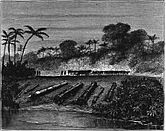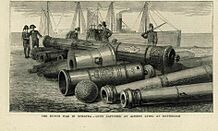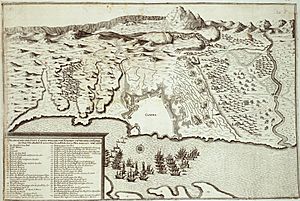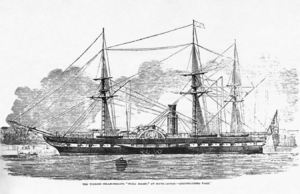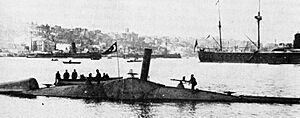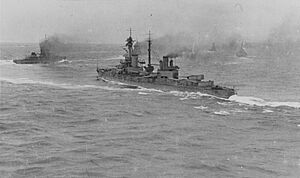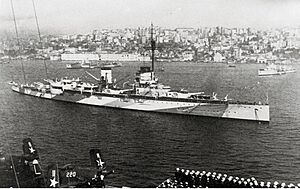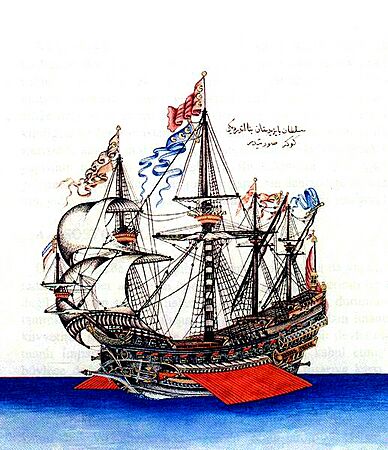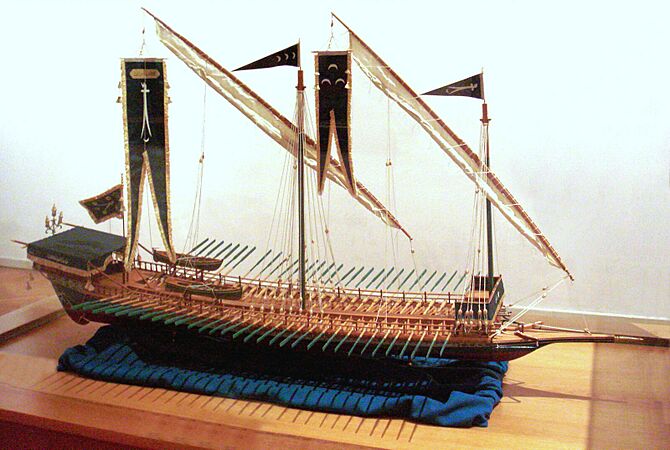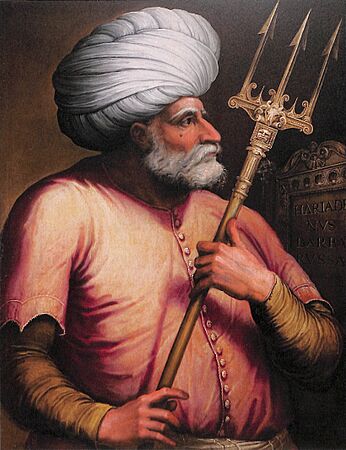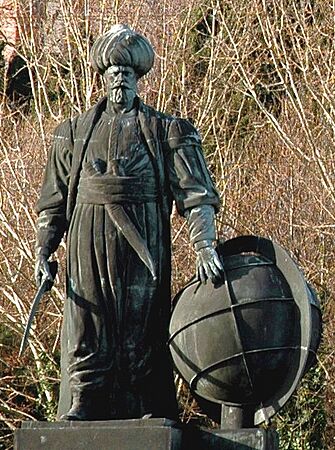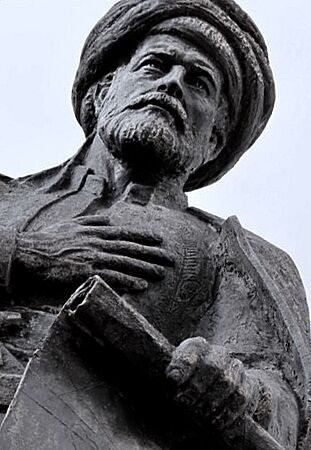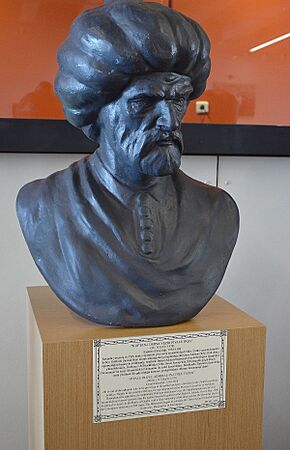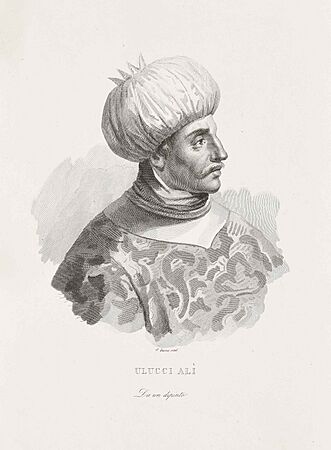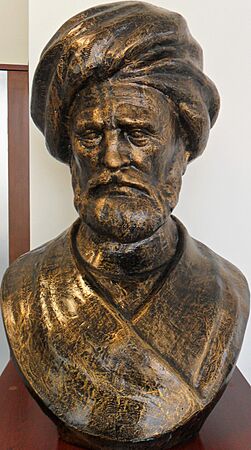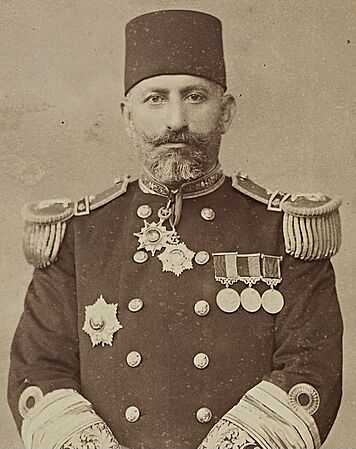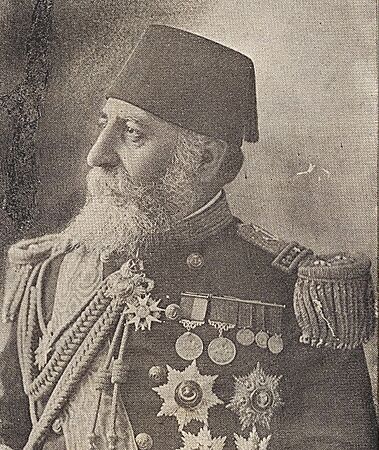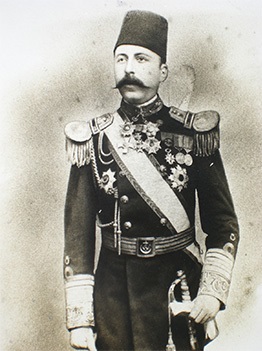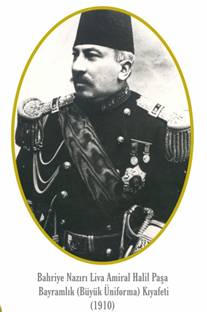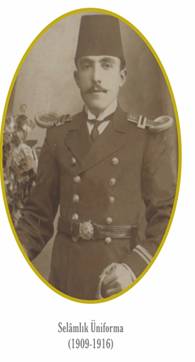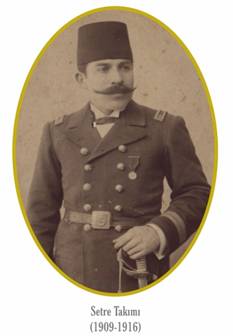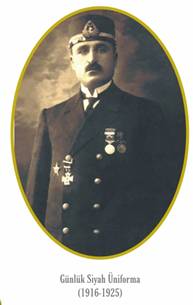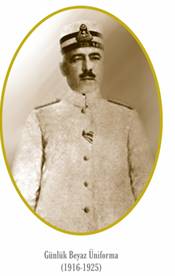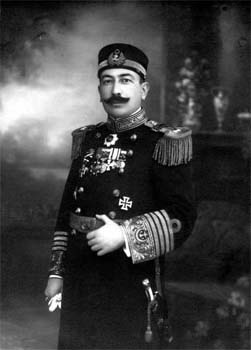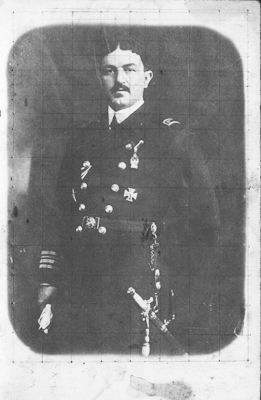Ottoman Navy facts for kids
Quick facts for kids Ottoman Navy |
|
|---|---|
| Turkish: Osmanlı Donanması | |

Naval standard of the Ottoman Sultan
|
|
| Active | 1323–1922 |
| Country | |
| Allegiance | |
| Type | Navy |
| Garrison/HQ | Ministry of the Navy, Constantinople |
| Engagements |
|
| Commanders | |
| Kapudan Pasha (1567–1867) |
|
| Minister of the Navy (1867–1922) |
|
| Fleet Commander (1877–1922) |
|
The Ottoman Navy (Turkish: Osmanlı Donanması), also known as the Imperial Navy or Ottoman Fleet, was the naval branch of the Ottoman Empire. It started in 1323 when the Ottomans reached the sea. They captured Praenetos, which became Karamürsel, home to their first naval shipyard. This shipyard was the beginning of the powerful Ottoman Navy.
For centuries, the Ottoman Navy was involved in many battles. It was very important in the conquest of Constantinople. It also helped the empire expand into the Mediterranean and Black Seas. At its strongest in the 1500s, the Navy even sailed to the Indian Ocean. In 1565, it sent an expedition to Indonesia. By the early 1600s, it reached as far as the Atlantic.
Later, the Ottoman Navy became less powerful. However, it remained one of the largest navies in the world. In the late 1700s, it had nearly 200 warships, including 21 battleships. This made it the third-largest navy, after Britain and France.
For most of its history, the Navy was led by the Kapudan Pasha, or Grand Admiral. This role ended in 1867. It was replaced by the Minister of the Navy and several Fleet Commanders.
After the Ottoman Empire ended in 1923, the Republic of Turkey was formed. The traditions of the Ottoman Navy continued with the modern Turkish Naval Forces.
Contents
Early Turkish Fleets
The first Turkish naval fleet in Anatolia was created in 1081. It was formed by Tzachas at the port of Smyrna (now İzmir). This fleet had 33 sailing ships and 17 oar ships. Tzachas's fleet attacked Lesbos in 1089 and Chios in 1090. On May 19, 1090, it defeated a Byzantine fleet. This was the first big naval victory for the Anatolian Turks.
Later, the Seljuq sultan Kayqubad I conquered Alaiye (now Alanya). He built a naval base there. Alanya became the main port for the Seljuk fleet in the Mediterranean Sea. Kayqubad I also created a fleet in the Black Sea at Sinope (now Sinop). This fleet conquered parts of the Crimean Peninsula and Sugdak between 1220 and 1237.
Expanding to New Seas
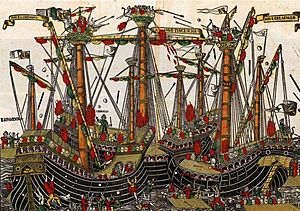

The Ottoman Navy's first victory was in 1308. They captured the island of Kalolimno (now İmralı Island) in the Sea of Marmara. In 1321, Ottoman ships first landed in Thrace (Europe). The first Ottoman fortress in Europe was built in 1351. By 1352, the Ottoman fleet controlled both sides of the important Bosporus and Dardanelles straits.
In 1373, the Ottomans landed on the Aegean coast of Macedonia. This led to the first Ottoman siege of Thessaloniki in 1374. Thessaloniki and Macedonia were fully conquered by 1387. From 1387 to 1423, the Ottoman fleet helped expand the empire. They gained more land in the Balkans and on the Black Sea coast.
The first Ottoman-Venetian War began in 1423. This happened after the Ottomans conquered some Venetian lands in Morea. The Ottoman fleet continued to expand. They conquered Sinop (1424) and Smyrna (1426). They also took Thessaloniki back from the Venetians in 1430. Between 1448 and 1479, the Ottoman fleet helped reconquer Albania.
In 1453, the Ottoman fleet played a key role in the historic conquest of Constantinople. They also conquered Gökçeada, Lemnos, and Thasos. The Duchy of Athens and the Despotate of the Morea were conquered between 1458 and 1460. In 1461, the Empire of Trebizond and the Genoese colony of Amasra were taken. This ended the last parts of the Byzantine Empire.
In 1462, the Ottoman fleet conquered Genoese islands in the northern Aegean Sea. This included Mytilene on Lesbos. This led to the Ottoman-Venetian War of 1463–1479.
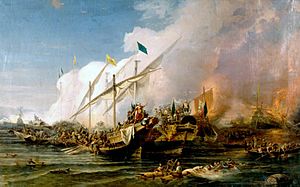
The Ottoman fleet gained more land in the Aegean Sea. In 1475, they reached Crimea on the northern Black Sea coast. By 1499, they expanded further on the Black Sea coast. They also gained more land in the Balkans. The loss of Venetian forts in Montenegro started the Ottoman-Venetian War of 1499–1503. During this war, the Turkish fleet of Kemal Reis defeated Venetian forces. This happened at the Battle of Zonchio (1499) and the Battle of Modon (1500). By 1503, the Ottoman fleet had taken all Venetian lands in Morea. They also controlled the Ionian Sea and southeastern Adriatic Sea coasts.
A typical Ottoman fleet in the mid-1600s had 46 ships. These included 40 galleys and 6 larger ships. They had about 15,800 crew members. About two-thirds were rowers, and the rest were fighters.
Expansion to the Levant and North Africa
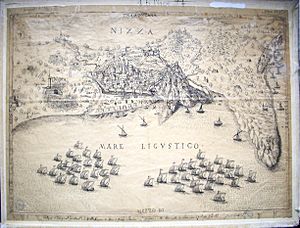
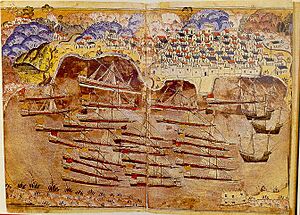
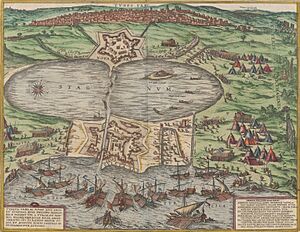
Starting in 1516, the Ottoman fleet under Selim I expanded the empire. They moved into the Levant and the Mediterranean coasts of North Africa. Between 1516 and 1517, Algeria was conquered from Spain. Oruç Reis led this conquest and joined the Ottoman Empire. Then, Egypt was conquered in 1517, ending the Mameluke Empire.
In 1522, the strategic island of Rhodes was conquered. It was the home of the Knights of St. John. Suleiman I allowed the Knights to leave. They moved their base to Sicily and then to Malta.
In 1527, the Ottoman fleet helped conquer parts of Dalmatia, Croatia, Slavonia, and Bosnia. In 1529, the Ottoman fleet destroyed a Spanish fleet near Formentera. This was followed by the first conquest of Tunisia from Spain. Hayreddin Barbarossa's forces also reconquered Morea. His fleet later conquered islands belonging to the Duchy of Naxos in 1537.
Afterwards, the Ottoman fleet attacked the Venetian island of Corfu. They also landed on the coasts of Calabria and Apulia. This forced Venice and Habsburg Spain to ask the Pope for help. A Holy League was formed. It included Spain, Venice, Genoa, the Papal States, and the Knights of Malta. The Holy League fleet was led by Andrea Doria.
The Holy League and the Ottoman fleet met in September 1538. This was the Battle of Preveza. It is often seen as the greatest Turkish naval victory. In 1543, the Ottoman fleet joined French forces in the siege of Nice. After this, Francis I of France allowed the Ottoman fleet to spend the winter in Toulon, France. This unique Ottoman wintering in Toulon allowed the Ottomans to attack Spanish and Italian ports. They left Toulon in May 1544.
Between 1541 and 1555, the Spanish-Italian fleet of Charles V was defeated several times. These defeats happened in Algiers, Naples, Ponza, and Piombino.
Operations in the Indian Ocean
The Ottoman Indian Ocean Fleet was based in Suez and Basra. It defeated Portuguese forces many times near the Arabian peninsula. They conquered Aden and Yemen (1538–1539), which were important Portuguese ports. They also took Jeddah and Djibouti on the Red Sea coast. However, the Ottoman siege of Diu in 1538 failed to remove the Portuguese from India.
Between 1547 and 1548, Yemen was reconquered from the Portuguese. In the Persian Gulf and Arabian Sea, other important Portuguese ports like Oman and Qatar were conquered in 1552. But the Ottomans could not take Hormuz Island. So, Portugal kept control of the Persian Gulf.
In 1565, the Sultanate of Aceh in Sumatra (Indonesia) joined the Ottoman Empire. In 1569, the Ottoman fleet sailed to new ports. It reached Aceh with 22 ships. This was the easternmost expansion of the Ottoman Empire.
The Ottoman naval victories at Battle of Preveza (1538) and Battle of Djerba (1560) gave them control of the Mediterranean Sea for decades. However, the Ottomans suffered their first big defeat at the Battle of Lepanto (1571). But this defeat was only temporary. It did not stop the Ottoman conquest of Cyprus. Within a year, the Ottomans built a new, equally large fleet. In 1574, this fleet conquered Tunisia from Spain. This completed the Ottoman conquest of North Africa.
Operations in the Atlantic Ocean
Starting in the early 1600s, the Ottoman fleet began sailing into the Atlantic Ocean. Earlier, Kemal Reis had sailed to the Canary Islands in 1501. Murat Reis the Elder captured Lanzarote in the Canary Islands in 1585.
In 1617, the Ottoman fleet captured Madeira in the Atlantic. In August 1625, they raided coastal areas of western England. In 1627, Ottoman ships and Barbary corsairs captured Lundy Island. This island in the Bristol Channel became a base for Ottoman operations in the North Atlantic for five years. They raided the Shetland Islands, Faroe Islands, Denmark-Norway, and Iceland. Between 1627 and 1631, they also raided the coasts of Ireland and Sweden. Ottoman ships were even seen off the eastern coasts of North America.
Black Sea Operations

Before the Ottomans, the Seljuq sultan, Alaeddin Keykubad I, had a Black Sea fleet. It was based in Sinop. This fleet conquered parts of the Crimean peninsula and Sugdak between 1220 and 1237.
After conquering Constantinople in 1453, the Ottomans controlled the Mediterranean with their fleets. In 1475, Sultan Mehmed II used 380 galleys. His fleet conquered the Greek Principality of Theodoro. They also took the Genoese port towns in Crimea. Because of these conquests, the Crimean Khanate became a vassal state of the Ottoman Empire in 1478. This lasted until 1774.
The failure of the siege of Malta in 1565 was a turning point. The Holy League's victory over the Ottomans at the Battle of Lepanto in 1571 also showed a shift. For a time, the Black Sea was seen as a "Turkish Lake." Ottoman naval power there relied on three things. First, they controlled the Turkish Straits and the mouth of the Danube. Second, no other states in the region had strong navies. Third, there was almost no piracy on the Black Sea.
However, after the 1550s, Zaporozhian Cossacks began frequent naval raids. This changed control of the Black Sea. The Cossacks used small, fast rowing boats called chaikas. These boats could hold up to seventy men and had cannons. They were hard to spot and very easy to move. In the early 1600s, Cossacks formed fleets of up to 300 boats. They attacked towns like Caffa, Varna, Trabzon, and even parts of Constantinople.
A French engineer, Guillaume Levasseur de Beauplan, wrote about Cossack tactics. The Cossack attacks peaked in 1637. A large group of Cossacks attacked the fortress of Azov. After a two-month battle, the Cossacks conquered the fortress.
The Ottoman Navy also blocked Georgia's western coast. This was done in the 1500s and 1600s to make local kingdoms surrender.
Stagnation (1683–1827)

In the late 1600s and 1700s, the Ottoman fleet mostly operated in the Mediterranean Sea, Black Sea, Red Sea, Persian Gulf, and Arabian Sea. The long Ottoman-Venetian War of 1645–1669 ended with an Ottoman victory. This completed the conquest of Crete, marking the empire's largest territory. In 1708, Oran (the last Spanish stronghold in Algeria) was conquered.
The 1700s were a period of ups and downs for the Ottoman fleet. They had many victories but also many defeats. Important Ottoman naval victories included taking back Moldavia and Azov from the Russians in 1711. The Ottoman–Venetian War of 1714–1718 saw the Ottomans reconquer Morea from the Venetians. They also removed the last Venetian island strongholds in the Aegean.
For most of the 1700s, the Ottoman Navy focused on protecting its waters. It also defended trade routes and fought against piracy.
However, during the Russo-Turkish War of 1768–1774, the Ottoman fleet was destroyed. This happened at the Battle of Chesme (1770). The next Russo-Turkish War (1787–1792) also saw many naval defeats. These were at the hands of the Russian Black Sea Fleet.
During the Greek War of Independence (1821–1829), Greek rebel ships challenged Ottoman naval power. They blocked Ottoman forts in Morea. In 1824, the Ottoman-Egyptian fleet joined the fight. This stronger fleet gained the upper hand. It successfully invaded Crete and Morea. However, in 1827, combined British, French, and Russian fleets arrived. They destroyed most of the Ottoman-Egyptian navy at the Battle of Navarino.
| Size of crew in Ottoman ships in 1699 and 1738 | ||||||||||||||||||||
|---|---|---|---|---|---|---|---|---|---|---|---|---|---|---|---|---|---|---|---|---|
| Size of crew | ships in 1699 | ships in 1738 | ||||||||||||||||||
| 1500 | - | 1 | ||||||||||||||||||
| 1300 | - | 1 | ||||||||||||||||||
| 1100 | - | 1 | ||||||||||||||||||
| 1000 | - | 1 | ||||||||||||||||||
| 800 | - | 6 | ||||||||||||||||||
| 750 | - | 5 | ||||||||||||||||||
| 650 | - | 4 | ||||||||||||||||||
| 600 | 1 | - | ||||||||||||||||||
| 500 | - | 1 | ||||||||||||||||||
| 450 | - | 7 | ||||||||||||||||||
| 400 | 2 | 3 | ||||||||||||||||||
| 350 | 3 | 1 | ||||||||||||||||||
| 300 | 8 | 1 | ||||||||||||||||||
| 250 | 3 | 1 | ||||||||||||||||||
| 200 | 3 | - | ||||||||||||||||||
| Total | 20 | 33 | ||||||||||||||||||
| Note: Between 1699 and 1738, the Ottoman navy started using more sailing ships. These ships needed more crew members than the older galleys. | ||||||||||||||||||||
Danube Fleet
The Ottoman Navy also had a fleet on the Danube River. In the late 1600s, during the Great Turkish War, this fleet had 52 vessels. These included 4 galliots, 28 frigates, and 20 flat-bottomed river boats. They were manned by 4,070 crew members.
The 1800s saw the Ottoman Navy decline further. After the defeat at the Battle of Navarino in 1827, Sultan Mahmud II wanted a strong, modern navy. The first steam ships were bought in 1828. In 1829, the world's largest warship for many years was built. This was the Mahmudiye, a ship of the line with 128 cannons. It carried 1,280 sailors.
In the 1830s, about 2,500 Christian sailors joined the Ottoman navy. Many were Armenians and Greeks. This caused some problems for Christian communities. Many Greeks from Rhodos and Chios fled to smaller islands. In 1847, Christian sailors asked for their own priests and chapels on warships. This request was not granted.
In 1875, during Sultan Abdülaziz's rule, the Ottoman Navy had 21 battleships. It also had 173 other warships. This made it the third-largest navy globally. However, the empire's economy was struggling. It could not afford to maintain such a large navy.
Sultan Abdülhamid II knew the empire needed a navy to protect itself from Russia. But the economic crisis of 1875 and the Russo-Turkish War (1877–1878) made it impossible. The late 1800s saw rapid changes in naval technology. The Ottoman Navy quickly became outdated. It needed to replace its warships often to keep up. But the poor economy made this impossible.
The Nordenfelt-class Ottoman submarine Abdül Hamid (1886) was special. It was the first submarine in history to fire a torpedo while underwater. Two of these submarines were built for the Ottoman Navy. They were assembled in Istanbul. These submarines were an attempt to gain an advantage over the Greek navy. However, they had stability problems and were hard to use. The Ottoman Navy struggled to find crews willing to serve on them. Abdül Hamid ended up unused, and Abdül Mecid was never fully finished.
After the Young Turk Revolution in 1908, leaders wanted a strong navy. A naval parade in 1910 showed the fleet was in poor condition. So, the Ottoman Navy Foundation was created. It raised money from public donations to buy new ships.
In 1910, the Ottoman Navy bought two battleships from Germany. These were SMS Weissenburg and SMS Kurfürst Friedrich Wilhelm. They were renamed Turgut Reis and Barbaros Hayreddin.
The Italo-Turkish War (1911–1912) and the Balkan Wars (1912–1913) were disastrous for the Ottoman Empire. In the first war, Italy took Ottoman Tripolitania (now Libya) and the Dodecanese Islands. The Italian navy defeated Ottoman ships. In the Balkan Wars, a smaller Greek fleet defeated Ottoman battleships. The stronger Greek fleet helped free all Ottoman-held Aegean islands. It also stopped Ottoman support from reaching land battles in the Balkans. The only Ottoman naval successes were raids by the light cruiser Hamidiye.
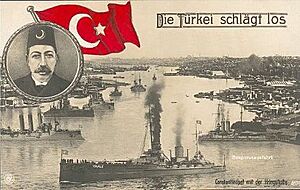
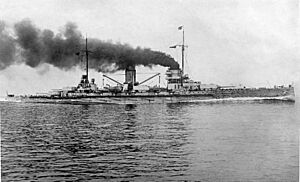
After the Balkan Wars, the Ottomans and Greece argued over the North Aegean islands. A naval race began in 1913–1914. The Ottoman Navy ordered large battleships. These included Sultan Osman-ı Evvel and Reşadiye. Public donations helped pay for them.
The Ottoman government paid for both battleships. They sent a delegation to the United Kingdom to collect them. But when World War I started in August 1914, the British government seized them. They renamed them HMS Agincourt and HMS Erin. This made the Ottoman public very angry at Britain. The German Empire took advantage of this. The German battlecruiser SMS Goeben and light cruiser SMS Breslau arrived at the Dardanelles. They joined the Ottoman Navy as Yavuz Sultan Selim and Midilli. These events helped lead the Ottomans to join World War I on the side of the Central Powers.
World War I and Aftermath
The Ottomans' first military action in World War I was the Black Sea raid. This was a surprise attack by the Ottoman Navy on the Russian Black Sea coast in October 1914. This attack led Russia, Britain, and France to declare war on the Ottoman Empire. During WWI, the Ottoman Navy fought the Entente Powers in the Mediterranean and Black Sea.
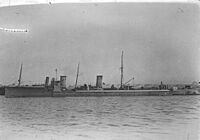
In 1915, at the Battle of Gallipoli, the British and French fleets tried to pass through the Dardanelles Strait. They failed because of strong Turkish defenses. These included heavy fortifications, mines laid by ships like Nusret, and fierce fighting by Turkish soldiers. During the battle, the British submarine HMS E11 sank Barbaros Hayreddin.
In 1918, Midilli sank after hitting five mines. This happened while returning from a mission to bombard the Allied port of Mudros. During that mission, Midilli and Yavuz Sultan Selim had sunk two British warships. They also sank a transport ship and bombarded Allied posts. The battlecruiser Yavuz Sultan Selim was very active during WWI. It bombarded many ports and fought Russian battleships. It also sank several Russian and British ships.
After World War I, the winning Entente Powers dissolved the Ottoman Navy. The large Ottoman ships were moved to the Prince Islands under Allied control. Some were scrapped.
After the Republic of Turkey became independent in 1923, the remaining major warships were repaired. These included the battlecruiser TCG Yavuz and battleship TCG Turgut Reis. New ships and submarines were bought starting in the 1930s.
Admirals

Here are some famous Ottoman admirals:
- Kemal Reis: He twice defeated the Venetian fleet in 1499 and 1500.
- Hayreddin Barbarossa: He defeated the Holy League fleet of Charles V in 1538 and 1541.
- Turgut Reis (known as Dragut): He conquered Libya in 1551. He also defeated the fleet of Charles V in 1552.
- Piyale Pasha: He defeated the Holy League of Philip II of Spain in 1560.
- Aruj: He established the Ottoman presence in North Africa.
- Salih Reis: He conquered Morocco in 1553, extending Ottoman territory into the Atlantic.
- Uluç (Kılıç) Ali Reis: He helped restore Ottoman control of the Mediterranean after the Battle of Lepanto in 1571. He conquered Tunisia from Spain in 1574.
- Murat Reis: He fought the Portuguese in the Indian Ocean. He also captured Lanzarote in the Canary Islands in 1585.
- Seydi Ali Reis: He fought the Portuguese in the Indian Ocean in 1554. He is famous for his travel books.
- Kurtoğlu Muslihiddin Reis: He was important in the conquests of Egypt (1517) and Rhodes (1522). He also started the Ottoman Indian Ocean Fleet. His son, Kurtoğlu Hızır Reis, led the Ottoman naval expedition to Aceh (1568–1569).
The Ottoman admiral and mapmaker Piri Reis created maps and navigation books. His first world map (1513) is one of the oldest maps of America. It might also be the oldest map of Antarctica. His maps are kept at the Library of Topkapı Palace in Istanbul. Other works by Piri Reis are at the Naval Museum in Istanbul.

The Istanbul Naval Museum is in the Beşiktaş district of Istanbul, Turkey. It was founded in 1897 by the Ottoman Minister of the Navy, Bozcaadalı Hasan Hüsnü Pasha.
The museum has a large collection of military items from the Ottoman Navy. It is Turkey's largest maritime museum. It has about 20,000 items. This includes the Tarihi Kadırga, a 16th or 17th century Ottoman galley. This ship is the only original galley still existing in the world. It also has the world's oldest continuously maintained wooden hull.
The museum is connected to the Turkish Naval Forces Command. It is also the country's first military museum.
A new exhibition building was built in the early 2000s. Construction started in 2008 and it reopened in 2013. It has two floors above ground and one basement floor. The total area is 20,000 square meters.
The basement has items like figureheads, ship ornaments, and ship models. It also has parts of the Byzantine chain. This chain was used to block the entrance of the Golden Horn during the Ottoman conquest of Constantinople in 1453. The first and second floors display many imperial and other caïques (small boats).
Many items in the museum have been specially restored. This is to protect them from damage caused by heat, light, humidity, and other factors.
Images for kids
-
"Göke" (1495) was the flagship of Kemal Reis
-
Barbarossa's galley during his campaign in France (1543–1544)
Ships
- List of battleships of the Ottoman Empire
- List of cruisers of the Ottoman Navy
- List of major surface ships of the Ottoman steam navy
- List of mine warfare vessels of the Ottoman steam navy
- List of non-combat vessels of the Ottoman steam navy
- List of patrol vessels of the Ottoman steam navy
- List of sail frigates of the Ottoman Empire
- List of ships of the line of the Ottoman Empire
- List of wrecked or lost ships of the Ottoman steam navy
See also
- List of Ottoman sieges and landings
- List of Fleet Commanders of the Ottoman Navy
- List of Kapudan Pashas
- Turkish Navy
- The Ottomans: Europe's Muslim Emperors


